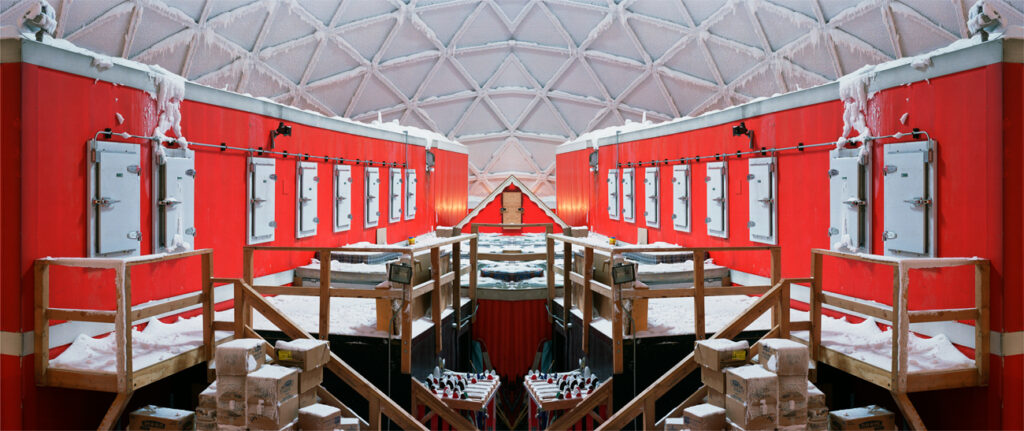These dreams reveal, in part, my aesthetic preoccupation with SF,science/speculative fiction, mostly as it pertains to how the U.S. dreams itself at various junctures. Given that SF is a literary genre central to the United States, some have commented, such as writer Claire Phillips, that perhaps SF is to this country what magic realism is to parts of Latin America. Although preceded and influenced by the writings of the British 19th century futurists, U.S. science fiction was first formalized in 1926 with the publication of Hugo Gernsback’s magazine,Amazing Stories. 1 Over the decades, SF has evolved (as well as de-evolved) past Gernsback’s initial editorial dictates that all stories in the magazine must include accurate portrayals of technology as well as masculine heroic trajectories. The title of the series of works I did in Antarctica, V.A.L.I.S. (vast active living intelligence system), borrows its title from the decidedly anti-heroic, psychologically-centric science fiction work of Philip K. Dick, writings which are often populated by failed men and underscore the fact that technology is, in and of itself, dumb, and that intelligence, whether organic, mechanical, or a combination of the two, is subject to multiple forms of symbolic order and slippage. 2

Amundsen-Scott Station Phase III (triptych)
digital print
Courtesy of the artist
Although Dick’s V.A.L.I.S. is part of a semi-autobiographical trilogy related to his religious conversion in later years, my appropriation of his title was more out of a shared interest in the overall ideas that run throughout Dick’s writings of transcendence and technology, the ability to perceive multiple timelines and realities, and the ever shifting membrane between fiction and the real world. Part of what interested me at the Pole are the different ways in which the U.S., since mid-century, has architecturally envisioned both the future and the colonizing of spaces where there are no indigenous peoples. While the U.S. station is optimally positioned should the non-sovereign Antarctic treaty unravel, few countries can afford to build at the South Pole given the constant drift and movement of the ice. No matter how smart the engineering, ice covers any built environment there in 40 or so years. Moreover, the geographic center of the Pole is also in constant flux. Even if a building could last more than a century, within three decades it would no longer be near the geographic center. While at the South Pole, I felt a poetic relief as I observed and documented the geological timeline indifferently erasing attempts to colonize the polar plateau. However, witnessing the ultimate trumping of the ice over occupation also left me with an overwhelming feeling of taking on a project that could not be completed. At first somewhat paralyzing, I later came to (once again) realize that there was no whole to be had (the mental space of empire) but rather the more “realistic” approach was to chart the shifting juxtapositions between landscape and built environment as fragmented and momentary.

Detail Figure 1, panel 1 from Amundsen-Scott Station Phase III (triptych)
digital print
Courtesy of the artist
In some ways this was an intentional counterpoint to the typical, historical impulse to photograph such vast landscapes panoramically. For example, one often sees photographs of the Pole shot with a “fisheye,” the widest of lenses, an understandable inclination. Because photography is driven by realism (much contemporary art photography has been about disrupting this assumption), the visual desire is to capture as much of the vista as possible into a single frame. The result is hardly realistic. The unnatural bending around of the image caused by the fisheye’s optics (as though the curvature of the planet is wrapping itself in the opposite direction) only underscores the artificiality of any form of representation. This normalized lure of the panorama can also be attributed to its longstanding history as the first Western virtual tourist space. Two hundred years ago, Europeans paid to immerse themselves in tunnels of painted panoramas of places to which they could never travel. The South Pole, a location accessible to only an elite few, seems to “naturally” lend itself to a form of representation developed in an era when the majority of Europeans rarely ever traveled more than a few kilometers from home.

Detail Figure 2, panel 2 from Amundsen-Scott Station Phase III (triptych)
digital print
Courtesy of the artist
Although not shot as panoramas, most of the photographs in the V.A.L.I.S. series are printed in mural size. The images are also formally constructed using a type of abstraction reminiscent of mid-century U.S. modernist architecture and painting. Most are shot with a long lens in order to play to the disorienting sense of scale between the landscape and structures that occurs when buildings are viewed close-up.

Dome Interior
digital print
Courtesy of the artist
The images are also composed to appear as alternating filmstrips of abstraction and realism, as a means to visually entangle the binary of real world and fabrication. Although I draw somewhat from the style of contemporary German photography first associated with Bernd and Hilla Becher, and sometimes termed “deadpan,” my interest is more in the paradoxical and interdependent relationships between documentary and the imaginary than it is to construct a wholly unsentimental image. 3 Yet, some of the images, such as the triptych of the new Amundsen-Scott Station under construction, do appear “cold” and lacking in emotion (see Figure 1, Figure 2 and Figure 3). Conversely, others, such as the “Dome Interior,” appear “warmer,” but no less visually confusing (see Figure 4). The reason for the difference in semiotic temperatures between photographs is related to the variation in design and tropes of modernity during the particular decade in which a given station was erected.
- The literary trajectory of SF in the U.S. is much more complicated than I can talk about here. However, for an excellent cultural history of science fiction (U.S. and British) and an in-depth discussion of how the genre consistently reinvents itself, see Roger Luckhurst, Science Fiction. Cambridge, UK: Polity Press, 2005.[↑]
- Philip K. Dick, Valis. New York: Vintage, 1991.[↑]
- For a further discussion on “deadpan” photography, as well as an overall introduction to contemporary art photography, see Charlotte Cotton, Photography as Contemporary Art. London: Thames and Hudson, 2004.[↑]



